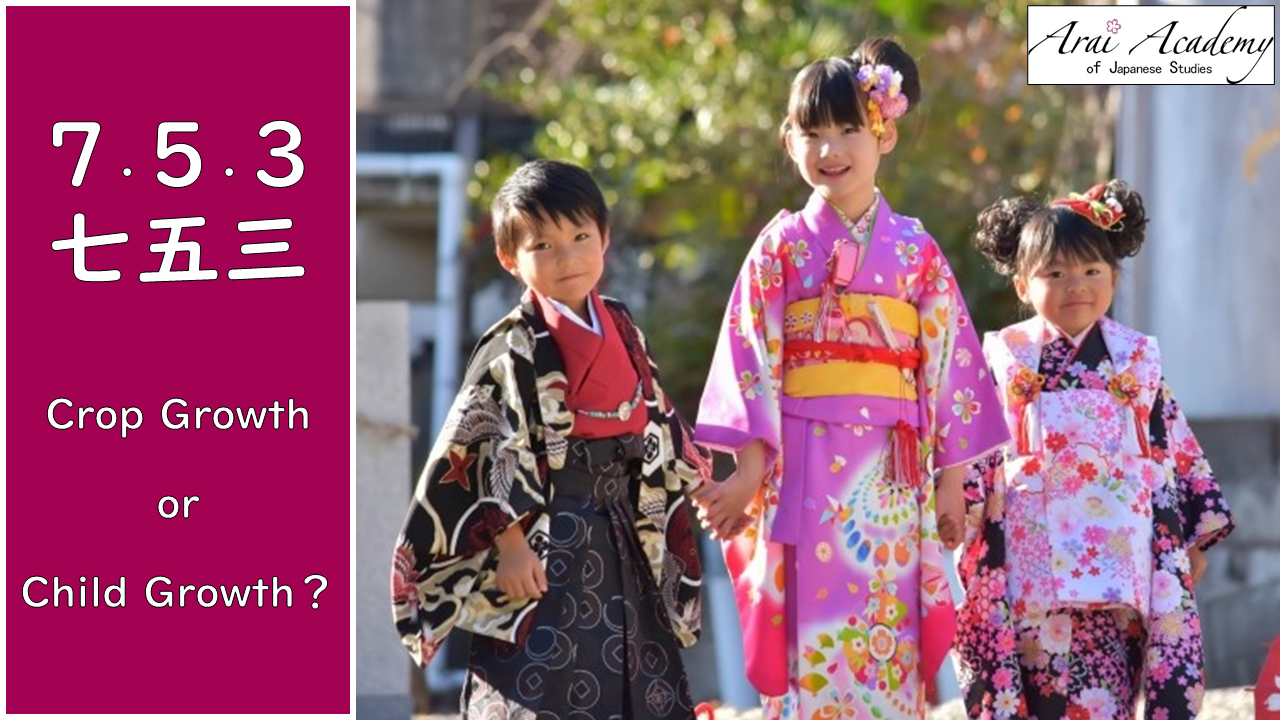‘Shichi・go・san’ - The Japanese Tradition on November 15th
Nov 13, 2022
こんにちは。毎年11月15日は「七五三」で、3歳、5歳、7歳の子供の成長を祝う、また願うイベントです。日本では収穫の時期と重なります。今回は「七五三」を行う①年齢について、②時期について、③祝い方についてご紹介します。今回も皆様にとって何か人生の学びとなれば嬉しいです。
Hello everyone. Did you know 15th November is ‘Shichi・go・san’ and parents celebrate their child's growth up to 3, 5 and 7 years old and wish for even further growth. It is also the season of crop growth and harvesting in Japan. I’ll introduce 1) the ages, 2) the timing and 3) things to do on ‘Shichi・go・san’. I hope it will broaden your views in your life.
①昔は無事成長できる子供が少なかったので、神社に行って、これまでの成長に感謝し、これからの成長を祈りました。 子供は3歳の時に髪を長くして、男の子は5歳の時に袴を着て、女の子は7歳の時に着物を着るという習慣があったので、この歳にお祝いするようになったそうです。それで今でも「七五三」に和服を着て、5歳は男の子、7歳は女の子のお祝いをします。3歳は地方によって女の子だけか男の子のお祝いもするそうです。(ウィキ参照)
1) Many children could not survive for long in the past and parents visited a shrine and appreciated and wished for the child's growth to the god. There was a custom that children grew hair at the age of 3, boys started wearing ‘hakama (like samurai)’ at the age of 5 and girls started wearing ‘kimono’ at the age of 7 .(Wiki) Therefore, those children wear traditional Japanese clothes on ‘Shichi・go・san’
②また、「七五三」の時期については旧暦の11月がちょうど収穫を終えて神に実りを感謝する月だったことに関係しています。縁起がいい満月の15日に神社で神様に感謝をするだけでなく、子供の成長にも感謝し、これからの成長も祈るようになったそうです。(ウィキ参照)
2) November on the lunar calendar was the time after harvesting and 15th was the full moon which was considered as a lucky day. And people appreciated the god for the crop growth and started appreciating child growth and wished for their long life as well.
農作物の成長と子供の成長を同じような感覚で見ているところが神道らしい考え方だと思います。私たちは自然に生かされているという意識が感じられますね。
I feel it is a kind of Shintoism viewpoint that people saw the link between crop growth and child growth. It can mean that nature gives us lives.
ちなみに2022年の11月の満月は8日で皆既月食でしたが、見ましたか。満月の日は変わりますが、15日が基本で、現代では会社勤めなどで15日に「七五三」ができない家庭はその前に神社に行くことが多いそうです。
By the way, did you see the full moon and a total lunar eclipse on 8th of November this year? A full moon day changes but 15th was kept and people tend to visit a neighbour shrine by 15th if parents are working on 15th in the modern time.
③「七五三」のお祝いでは子供は「千歳(ちとせ)飴(あめ)」の袋を持って歩きます。「千歳」は「千年」という意味ですから、長生きを願った飴で、細長い形をしていて、縁起がいい赤と白の1本ずつが袋に入っています。袋には長生きでゆうめいな鶴(つる)と亀(かめ)が描かれています。
3) It is a typical scene that children walk around holding a beautiful long paper bag with ‘Chitose ame’. ‘Chitose’ means ‘a thousand years’ and ‘ame’ means ‘lolly’ and it is often 15 cm long wishing for a long life. There is one white ‘ame’ and one red ‘ame’ as red and white are lucky colours in Japan. The bag has a design of a crane and a turtle as their life is relatively long.
私が7歳の時、「七五三」についてよくわからないまま着物を着せられ、メークをされ、神社に行ったのを覚えています。子供にとって着物や草履(ぞうり)で神社を歩くのは大変でしたが、なにか特別な気分を味わったり、甘い「千歳飴」を食べたりして楽しんでいたのを覚えています。 カメラの前でポーズを取ったりと、カメラにはまっていた父にちゃんと父親サービスもしていました(笑)。
When I was at 7, I remember I was taken to a hairdresser and put on kimono and make-up and went to the shrine holding the ‘Chitose ame’ without a clear understanding of ‘Shichi・go・san’. It was hard to walk with a kimono and ‘zori (Japanese sandals)’ for a child but I enjoyed the feeling of something special and the sweet ‘Chitose ame’. I also kept posing in front of the camera just for my father who was crazy about photography. :)
皆さんの国では子供の成長を祝うイベントがありますか。それはどの時期に行いますか。お互いに異文化を学び合えたら嬉しいです。今回も日本に関する記事を読んでくださってどうもありがとうございます。みなさまの学びとなれば幸いです。
What kind of event for child growth is held in your country? And when is it? It would be nice to share our cultures. Thank you very much for taking time to read about Japanese culture. I hope you have learnt something today.
「輝いて」- Enrich your life!
Mineko Arai
Managing Director
Arai Academy of Japanese Studies
Succeed in Japanese!
Q: Have you ever learnt how to study Japanese effectively?
Q: Do you feel like you're making progress?
Join our mailing list to receive FREE 'Tips for Achievement!'
We hate SPAM. We will never sell your information, for any reason.




